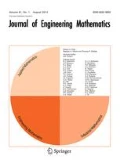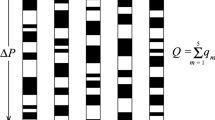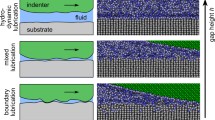Abstract
We report new analytical solutions for the thickness profile of partially wetting two-dimensional droplets. The model includes the effects of capillarity and both short- and long-range molecular forces. We analyze the dependence of the maximum thickness, the contact angle, and the cross-sectional area on the height of the nanometric precursor film that surrounds the droplet. We found asymptotic expressions for the thickness profile and for the contact angles for large and small droplets. The results are compared to those obtained previously for polar liquids. The analytical solutions found here are useful to assess the validity of the hypothesis and the semi-analytical solutions proposed in the literature. In addition, these solutions enable the inference of information about the molecular potential from the measured steady profiles.










Similar content being viewed by others
References
Bonn D, Eggers J, Indekeu J, Meunier J, Rolley E (2009) Wetting and spreading. Rev Mod Phys 81:739–805
Lai YH, Yang JT, Shieh DB (2010) A microchip fabricated with a vapor-diffusion self-assembled-monolayer method to transport droplets across superhydrophobic to hydrophilic surfaces. Lab Chip 10:499–504
Daunay B, Lambert P, Jalabert L, Kumemura M, Renaudot R, Agache V, Fujita H (2012) Effect of substrate wettability in liquid dielectrophoresis (ldep) based droplet generation: theoretical analysis and experimental confirmation. Lab Chip 12:361–368
Arscott S, Descatoire C, Buchaillot L, Ashcroft AE (2012) A snapshot of electrified nanodroplets undergoing Coulomb fission. Appl Phys Lett 100(7):074103
Roberts CC, Rao RR, Loewenberg M, Brooks CF, Galambos P, Grillet AM, Nemer MB (2012) Comparison of monodisperse droplet generation in flow-focusing devices with hydrophilic and hydrophobic surfaces. Lab Chip 12:1540–1547
Israelachvili JN (1992) Intermolecular and surface forces, 2nd edn. Academic Press, New York
Berim GO, Ruckenstein E (2004) On the shape and stability of a drop on a solid surface. J Phys Chem B 108:19330–19338
Nold A, Sibley DN, Goddard BD, Kalliadasis S (2014) Fluid structure in the immediate vicinity of an equilibrium three-phase contact line and assessment of disjoining pressure models using density functional theory. Phys Fluids 26(7):072001
Derjaguin B, Kusakov M (1936) Contact-line dynamics of a diffuse fluid interface. Izv Akad Nauk SSSR Ser Khim 5:741
Gomba JM, Homsy GM (2009) Analytical solutions for partially wetting two-dimensional droplets. Langmuir 25(10):5684–5691
Gomba JM, Perazzo CA (2012) Closed-form expression for the profile of partially wetting two-dimensional droplets under gravity. Phys Rev E 86(056):310
Gotkis Y, Ivanov I, Murisic N, Kondic L (2006) Dynamic structure formation at the fronts of volatile liquid drops. Phys Rev Lett 97(18):186101
Churaev NV, Sobolev VD (1995) Prediction of contact angles on the basis of the Frumkin–Derjaguin approach. Adv Colloid Interface Sci 61:1–16
Teletzke GF, Davis HT, Scriven LE (1987) How liquids spread on solids. Chem Eng Commun 55:41–82
Starov V, Velarde M, Radke C (2007) Wetting and spreading dynamics. Surfactant science series. CRC Press, Boca Raton
Derjaguin B, Churaev N (1974) Structural component of disjoining pressure. J Colloid Interface Sci 49(2):249–255
Derjaguin BV, Rabinovich YI, Churaev NV (1978) Direct measurement of molecular forces. Nature 272:313–318
Oron A, Bankoff SG (2001) Dynamics of a condensing liquid film under conjoining/disjoining pressures. Phys Fluids 13:1107–1117
Glasner KB, Witelski TP (2003) Coarsening dynamics of dewetting films. Phys Rev E 67:016302
Schwartz LW, Roy RV (2004) Theoretical and numerical results for spin coating of viscous liquids. Phys Fluid 16:569–584
Gratton MB, Witelski TP (2008) Coarsening of unstable thin films subject to gravity. Phys Rev E 77:016301
Gratton MB, Witelski TP (2009) Transient and self-similar dynamics in thin film coarsening. Physica D 238(23–24):2380–2394
de Gennes PG (1985) Wetting: statics and dynamics. Rev Mod Phys 57:827–863
Oron A, Bankoff S (1999) Dewetting of a heated surface by an evaporating liquid film under conjoining/disjoining pressures. J Colloid Interface Sci 218(1):152–166
Schwartz LW (1998) Hysteretic effects in droplet motions on heterogenous substrates: direct numerical simulations. Langmuir 14:3440–3453
Derjaguin B, Churaev NV, Muller V (1987) Surface forces. Springer, New York
Sur J, Witelski TP, Behringer RP (2004) Steady-profile fingering flows in marangoni driven thin films. Phys Rev Lett 93(24):247803
Thiele U, Neuffer K, Bestehorn M, Pomeau Y, Velarde MG (2002) Sliding drops on an inclined plane. Colloids Surf A 206:87–104
Brochard-Wyart F, Di Meglio JM, Quere D, De Gennes PG (1991) Spreading of nonvolatile liquids in a continuum picture. Langmuir 7(2):335–338
Zhang X, Neogi P, Ybarra R (2002) Stable drop shapes under disjoining pressure: I. A hierarchical approach and application. J Colloid Interface Sci 249(1):134–140
Pismen LM, Eggers J (2008) Solvability condition for the moving contact line. Phys Rev E 78(056):304
Lubarda VA, Talke KA (2011) Analysis of the equilibrium droplet shape based on an ellipsoidal droplet model. Langmuir 27(17):10705–10713
Diaz ME, Fuentes J, Cerro RL, Savage MD (2010) An analytical solution for a partially wetting puddle and the location of the static contact angle. J Colloid Interface Sci 348(1):232–239
Gaskell PH, Jimack PK, Sellier M, Thompson HM (2004) Efficient and accurate time adaptive multigrid simulations of droplet spreading. Int J Numer Methods Fluids 45(11):1161–1186
Koh YY, Lee YC, Gaskell PH, Jimack PK, Thompson HM (2009) Droplet migration: quantitative comparisons with experiment. Eur Phys J Special Topics 166(1):117–120
Gomba JM, Homsy GM (2010) Regimes of thermocapillary migration of droplets under partial wetting conditions. J Fluid Mech 647:125–142
Oron A, Davis SH, Bankoff SG (1997) Long-scale evolution of thin liquid films. Rev Mod Phys 69:931–980
Schwartz LW, Eley RR (1998) Simulation of droplet motion on low-energy and heterogeneous surfaces. J Colloid Interface Sci 202(1):173–188
Mitlin VS (1994) On dewetting conditions. Colloid Surf A 89:97–101
Bertozzi A, Grün G, Witelski TP (2001) Dewetting films: bifurcations and concentrations. Nonlinearity 14:1569
Glasner K, Witelski T (2005) Collision versus collapse of droplets in coarsening of dewetting thin films. Physica D 209:80–104
Teletzke GF, Davis H, Scriven LE (1988) Wetting hydrodynamics. Rev Phys Appl 23(6):989–1007
Abramowitz M, Stegun IA (1964) Handbook of mathematical functions with formulas, graphs, and mathematical tables. Dover, New York
Eggers J (2005) Contact line motion for partially wetting fluids. Phys Rev E 72:061605
Savva N, Kalliadasis S (2011) Dynamics of moving contact lines: A comparison between slip and precursor film models. Europhys Lett 94(6):64004
Kavehpour HP, Ovryn B, McKinley GH (2003) Microscopic and macroscopic structure of the precursor layer in spreading viscous drops. Phys Rev Lett 91:196104
Solomentsev Y, White LR (1999) Microscopic drop profiles and the origins of line tension. J Colloid Interface Sci 218(1):122–136
Dörfler F, Rauscher M, Dietrich S (2013) Stability of thin liquid films and sessile droplets under confinement. Phys Rev E 88:012402
Perazzo CA, Mac Intyre JR, Gomba JM (2014) Final state of a perturbed liquid film inside a container under the effect of solid–liquid molecular forces and gravity. Phys Rev E 89:043010
Acknowledgments
The authors gratefully acknowledge the funding supports via the CONICET Grants PIP No. 356 and PIP No. 299, and the ANPCyP Grant No. 2012-1707.
Author information
Authors and Affiliations
Corresponding author
Appendix: Relationship between the contact angles \(\varTheta _s\) and \(\varTheta \)
Appendix: Relationship between the contact angles \(\varTheta _s\) and \(\varTheta \)
In this study, we establish the connection between the thermodynamic definitions of the contact angle \(\varTheta _s\), Eq. (42) and the contact angle \(\varTheta \) defined as the maximum slope of the dimensional profile (see Sect. 5.1). As we discussed in Sect. 6, \(\varTheta \rightarrow \varTheta _s\) only in the limit of large droplets.
In the following, we return to the dimensional variables. Thus, Eq. (7) takes the form:
where \(K=h_{xx}/(1+h_{x}^2)^{3/2}\) is the curvature, and P is an unknown constant [10, 11]. Imposing that \(K\rightarrow 0\) when \(h \rightarrow h_\mathrm{f}\) (film region), the value of P is
We now integrate Eq. (44) from \(h_\mathrm{f}\) to an arbitrary thickness H:
The three integrals in (46) can be calculated to get
where the angle \(\alpha \) is defined as the angle between the substrate and the profile at any h, i. e., \(\tan {\alpha }(h)=h_x\).
Equation (47) shows that the angle \(\alpha \) at any thickness H will depend on H and U. If we used \(K=h^{\prime \prime }(x)\), valid under the lubrication hypothesis, the left-hand side of Eq. (47) would read \(\gamma /2\tan ^2\alpha (H)\).
Notice that the angle \(\alpha \) evaluated at the point \(h_\mathrm{c}\), where the slope is maximum, is the contact angle of the dimensional profile \(\varTheta \). Then, to show that the thermodynamic contact angle \(\varTheta _s\) is the limit of \(\varTheta =\alpha (h_\mathrm{c})\) for large droplets, we first evaluate Eq. (47) in \(H = h_\mathrm{c}\)
We now consider large droplets by taking the limit \(h_\mathrm{f}\rightarrow h_*\). From Eqs. (45,31), we have \(\{U(h_\mathrm{c});(h_\mathrm{f}-h_\mathrm{c})P\}\rightarrow \{0;0\}\). Denoting \(\varTheta _*\equiv \varTheta (h_\mathrm{c}\rightarrow \infty )\) we conclude that, in this limit, Eq. (48) becomes
which is the usual definition for the thermodynamic contact angle \(\varTheta _s\) [47]. The conclusion is that \(\varTheta _* \equiv \varTheta (h_\mathrm{c} \rightarrow \infty ) = \varTheta _s\), and then \(\varTheta _s\) can only be observed in large droplets. As mentioned above, when the lubrication approximation is employed, the term \((1-\cos {\varTheta })\) is replaced by \(1/2\tan ^2\varTheta \) as shown in Eq. (42). Moreover, from the analysis in Sect. 5.1, where we show that the maximum slope monotonically increases as \(h_\mathrm{f}\) decreases, it is straightforward that the thermodynamic angle given in Eq. (49) is the upper limit of the observable contact angle \(\varTheta \), as discussed in the Conclusions.
From Eq. (49), we may also relate the strength of the disjoining pressure \(\kappa \) with \(\varTheta _s\), n, m, and \(\gamma \). Effectively, since
then
Again, if the curvature is approached as \(h_{xx}\), the factor \(1-\cos {\varTheta _*}\) is replaced by \(1/2\tan ^2{\varTheta _*}\). In the References the interested reader will find many examples where this relationship between the contact angle and \(\kappa \) is employed. Remarkably, there is a simple relationship between the values of \(\kappa \) and \(h_*\) with the Hamaker constants of the molecular forces. If the disjoining–conjoining pressure is written as \(\varPi =A_n/h^n-A_m/h^m\), where \(A_i\) is related to the Hamaker constant, then
and
which is explained in the Appendix of Ref. [10].
Rights and permissions
About this article
Cite this article
Mac Intyre, J.R., Gomba, J.M. & Perazzo, C.A. New analytical solutions for static two-dimensional droplets under the effects of long- and short-range molecular forces. J Eng Math 101, 55–69 (2016). https://doi.org/10.1007/s10665-016-9846-x
Received:
Accepted:
Published:
Issue Date:
DOI: https://doi.org/10.1007/s10665-016-9846-x




